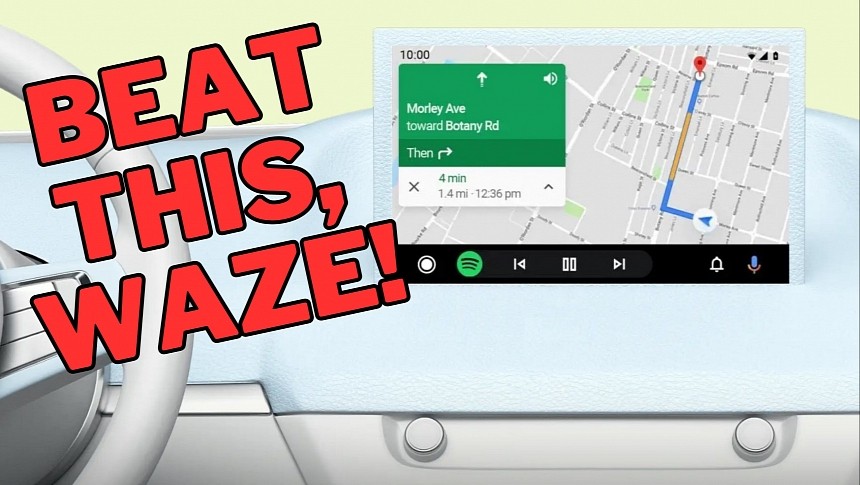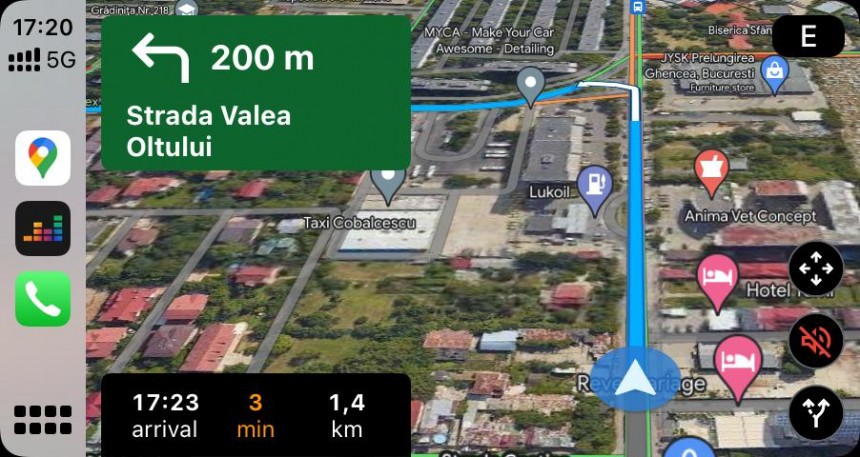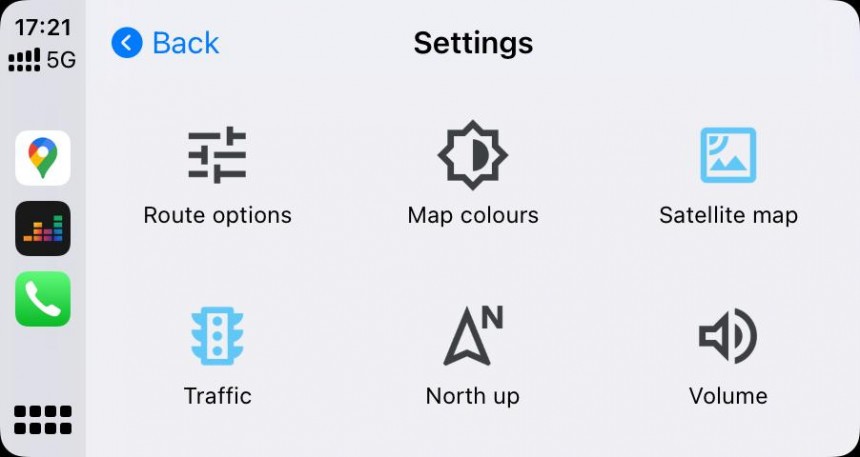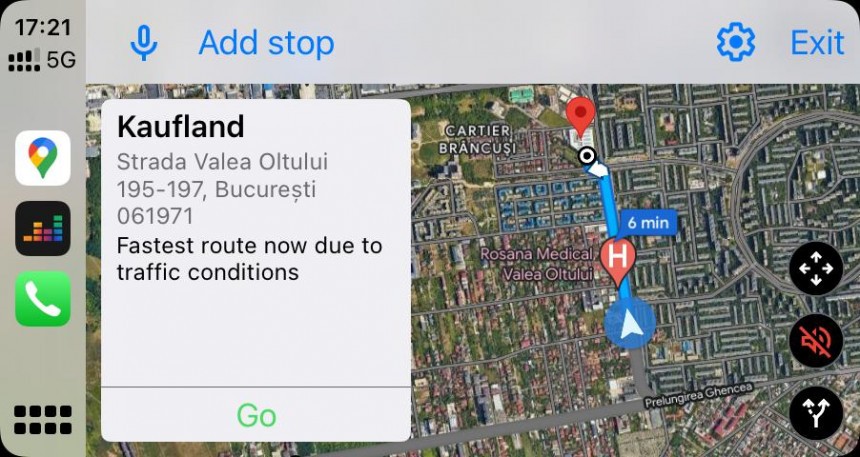As the world's number one mobile navigation application, Google Maps is equipped with both essential features and several extras to enhance the overall user experience.
In addition to must-have capabilities, such as turn-by-turn guidance and traffic data, Google Maps also supports voice instructions, allowing users to figure out where they need to go without looking at the screen.
From a driver's distraction perspective, this is a critical feature.
Once Google Maps starts providing navigation guidance, it highlights the route on the map alongside next-turn information and traffic details. However, given drivers would always have to look at the screen for turn-by-turn instructions, Google has also equipped Google Maps with voice instructions.
This means the application can speak the driving directions, allowing the driver to keep their eyes on the road while also receiving the necessary information to follow a recommended route.
Google Maps speaks the navigation directions via the phone's speakers (if it runs on a mobile device). The sound is routed to the car's speaker system when the smartphone is connected via Bluetooth or the app runs on Android Auto or CarPlay.
In theory, this approach makes perfect sense. This is how GPS navigators have worked for a very long time, and at the same time, it's also a very familiar approach that users don’t necessarily mind using.
Google has come up with a brilliant idea to improve voice instructions, turning to a smart approach that would make them interactive. In other words, users would be allowed to continue the conversation with Google Maps to obtain more information about their next turns.
Described in a patent called "interactive voice navigation," Google's idea borrows the conversational mode that the company has long been working on for Google Assistant. This means the application speaks a certain phrase and then waits for input from the user, eventually holding a conversation to provide more context on a certain task.
In the case of Google Maps, this approach could bring substantial value in terms of route guidance. With the interactive voice guidance, Google Maps would allow the user to ask for more information on the next turn or have the application repeat the spoken phrase.
For instance, when Google Maps tells the user to "turn left in 50 meters," the driver can ask the application to repeat the instruction if they can’t hear it clearly due to noise in the cabin. If another person is speaking or a loud engine makes it impossible to understand the spoken guidance, Google Maps would be able to say the same thing again.
More importantly, the navigation app would offer more context on a specific turn, clarifying where the driver must go according to the suggested route. For example, when Google Maps tells the user to "turn left in 50 meters," they can ask something like "is that the first or second intersection?" The application would then respond accordingly, therefore making it easier for the driver to understand where they need to make the left turn.
The interactive voice support can be further expanded with additional capabilities. Google Maps can offer additional context when trying to find a specific street number, as the user can ask for more information to figure out where they must stop the car.
Needless to say, Google's idea is currently in the patent stage, so it could take a while until the interactive voice model goes live for production devices. The search giant obviously needs more time to make it happen, though it can very well borrow the conversation model from Google Assistant.
On the other hand, such a feature would provide Google Maps with a substantial lead in the navigation race. Apple is investing big in Apple Maps, as the detailed city experience completely overhauls the maps offered to users. Apple's new map data includes super-accurate road details, including sidewalks, crosswalks, stop signs, traffic lights, and 3D building models for more straightforward navigation.
Apple has also tried to improve the conversational engine in Siri, but given Apple Maps is exclusive to iOS devices, such a feature would significantly limit the app's audience.
In the meantime, Google Maps remains the preferred navigation app on most platforms out there. While it comes pre-loaded on Android devices (and is therefore available on Android Auto as well), Google Maps is also the top alternative to Apple Maps on iPhone and CarPlay. Offline maps and satellite navigation, both of which are missing from Apple Maps, make Google Maps a very popular choice in the Apple ecosystem.
From a driver's distraction perspective, this is a critical feature.
Once Google Maps starts providing navigation guidance, it highlights the route on the map alongside next-turn information and traffic details. However, given drivers would always have to look at the screen for turn-by-turn instructions, Google has also equipped Google Maps with voice instructions.
This means the application can speak the driving directions, allowing the driver to keep their eyes on the road while also receiving the necessary information to follow a recommended route.
Google Maps speaks the navigation directions via the phone's speakers (if it runs on a mobile device). The sound is routed to the car's speaker system when the smartphone is connected via Bluetooth or the app runs on Android Auto or CarPlay.
How Google wants to overhaul voice instructions
Right now, voice navigation instructions are provided to users in the simplest and most straightforward way. Google Maps speaks guidance with basic phrases like "in 50 meters, turn left." As you approach an intersection, Google Maps drops the distance reference, telling you to "turn left" on the next street.In theory, this approach makes perfect sense. This is how GPS navigators have worked for a very long time, and at the same time, it's also a very familiar approach that users don’t necessarily mind using.
Google has come up with a brilliant idea to improve voice instructions, turning to a smart approach that would make them interactive. In other words, users would be allowed to continue the conversation with Google Maps to obtain more information about their next turns.
Described in a patent called "interactive voice navigation," Google's idea borrows the conversational mode that the company has long been working on for Google Assistant. This means the application speaks a certain phrase and then waits for input from the user, eventually holding a conversation to provide more context on a certain task.
For instance, when Google Maps tells the user to "turn left in 50 meters," the driver can ask the application to repeat the instruction if they can’t hear it clearly due to noise in the cabin. If another person is speaking or a loud engine makes it impossible to understand the spoken guidance, Google Maps would be able to say the same thing again.
More importantly, the navigation app would offer more context on a specific turn, clarifying where the driver must go according to the suggested route. For example, when Google Maps tells the user to "turn left in 50 meters," they can ask something like "is that the first or second intersection?" The application would then respond accordingly, therefore making it easier for the driver to understand where they need to make the left turn.
The interactive voice support can be further expanded with additional capabilities. Google Maps can offer additional context when trying to find a specific street number, as the user can ask for more information to figure out where they must stop the car.
Needless to say, Google's idea is currently in the patent stage, so it could take a while until the interactive voice model goes live for production devices. The search giant obviously needs more time to make it happen, though it can very well borrow the conversation model from Google Assistant.
Apple has also tried to improve the conversational engine in Siri, but given Apple Maps is exclusive to iOS devices, such a feature would significantly limit the app's audience.
In the meantime, Google Maps remains the preferred navigation app on most platforms out there. While it comes pre-loaded on Android devices (and is therefore available on Android Auto as well), Google Maps is also the top alternative to Apple Maps on iPhone and CarPlay. Offline maps and satellite navigation, both of which are missing from Apple Maps, make Google Maps a very popular choice in the Apple ecosystem.










